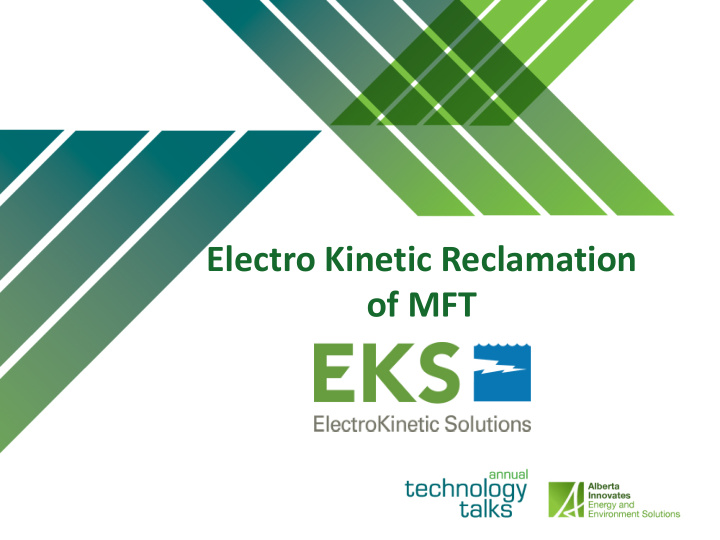



Electro Kinetic Reclamation of MFT
History of Development • 2010 : Initial theory tested at Univ. of Illinois at Chicago (Dr. Krishna Reddy) • 2011-2012 : Bench testing in Escondido • 2012-2013 : 5m electrode spacing, 2D & 1,000L tote testing in Escondido (sponsored by AI-ESS & Shell) 2014-present : 130 M³ & 25 M³ testing at C-FER • Technologies (sponsored by AI-ESS & Shell)
14 Days Treatment 330 L Water Separated 56.9% Solids Up to 200 kPa Shear Strength 109 kWh Used $8.72/m 3 treated $15.53/Dry tonne 330kW/m 3 Water Recovered
7 Weeks Treatment 190 kWh Used 260 L Water Separated ~30% Volume Reduction Greater electrode spacing may be 49.4% Solids possible Up to 135 kPa Shear Strength
Potential Applications Could be an in-pit deposit such as lake bottom Could be an above grade pond Vertical electrode arrangement with target densities dependent on final reclamation plans Water Cap MFT End Pit Lake Electrodes EKR Process Extract water and compact tailing in-place Extracted Water Post Compacted Tailings increasing capacity of the deposit. Treatment
Densification of New Deposits In-place dewatering with fines separation/compaction to improve fines capture in settling basins and disposal areas Makes use of existing facilities for in situ treatment of tailings Works on a range of solids contents Extracted water is suitable for return for process use Horizontal or Vertical Electrode arrangement
Purpose of Current Tests Apply EKR at tank scale Assess new hybrid electrode array design Test impact of: • larger scale • cold weather Refine EKS Model
Indoor Large Scale Testing 5m electrode spacing in 130m 3 of MFT Test effectiveness of hybrid electrode array Assess impact of scale on energy demand Refine EKS Model
Outdoor Testing 25m 3 outdoor test in open top ‘Baker Tank’ Demonstrate effectiveness of horizontal electrodes Operate in cold temperatures Calibrate predictive model for horizontal electrodes
Test Systems at C-FER 10
Metrics of Success Densify to 60% solids content Recovered water quality suitable for reuse Power costs $15-30/dry tonne Prove treatment system works at tank scale Assess Freeze/Thaw impacts
Treatment Results to Date 130m³ Tank Days of EKR Treatment: 335 Consumed Power: Approx.: 6,200KWh Released Water: Approx.: 80 M³ % Starting Solids: Approx.: 32 Current % Solids by Wt.: Approx.: 63 Treatment Costs: $ 10.25/Dry Tonne
Consumed Power: 130m³ Tank 8,000 7,000 6,000 Cumulative Power [kWh] 5,000 4,000 3,000 2,000 1,000 0 0 50 100 150 200 250 300 350 Treatment Days Cumulative Power (Model 31.75%) Cumulative Power (Actual) [kWh]
Released Water: 130m³ Tank 80 70 Released Water (m3) 60 50 40 30 20 10 0 0 50 100 150 200 250 300 350 Days of Treatment
% Change in Solids: 130m³ Tank 65% 60% 55% 50% 45% 40% 35% 30% 0 50 100 150 200 250 300 350 Days of Treatment
Treatment Costs: 130m³ Tank $10.25 $8.25 $/Dry Tonne $6.25 $4.25 $2.25 $0.25 0 50 100 150 200 250 300 350 Days of Treatment
Post EKR Treatment 25m³ Tank
Post EKR Treatment 25m³ Tank
Treatment Results 25m³ Tank Days of EKR Treatment: 256 with 145 of freeze* Consumed Power: Approx.: 3,000 KWh Released Water: Approx.: 15 m³ % Starting Solids: Approx.: 32 %Change in Solids: Approx.: 60 Treatment Costs: $ 27-34/Dry Tonne Comprehensive final report due November, 2015 *Per N. Beier at U of A, expect approx. 12-13% solids content from freeze (+/- 5%)
Next Steps EKR treatment of 130m³ until December Detailed post-treatment sampling Detailed research report end of Feb. 2016 Engineering design for possible full-scale field deployment in 2016
Recommend
More recommend